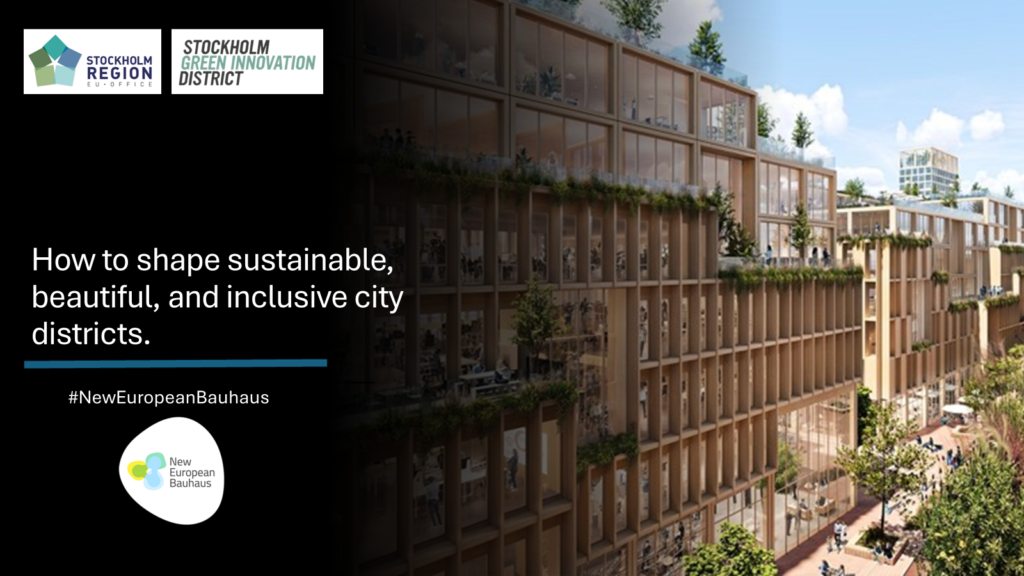
As a proud partner to the New European Bauhaus Festival, Stockholm Region EU Office, in collaboration with Stockholm Green Innovation District, hosted a breakfast seminar on the 9th of April to discuss how to shape sustainable, beautiful, and inclusive city districts with innovative and climate neutral solutions by and for citizens. The seminar aimed to present experiences best practices, and discuss challenges by different projects within Stockholm Green Innovation District (SGID).
Background
The seminar on “How to shape sustainable, beautiful, and inclusive city districts” was Stockholm Region EU Office’s second breakfast seminar this year. It occurred during The Festival of New European Bauhaus, which took place from 9 to 13 April in Brussels. The festival, an initiative of The European Commission, serves as a vibrant platform connecting the European Green Deal with the urban environment, emphasizing a sustainable and inclusive future. It celebrates the spirit of creativity, climate transition, collaborations, and forward-thinking design.
The seminar was hosted in collaboration with the Stockholm Green Innovation District (SGID). SGID is Stockholm’s new growth area for innovation and sustainability, stretching from the areas Årsta to Sickla. It is a citizen-driven climate transition with more than 50.000 inhabitants and 20.000 workplaces. The network consists of 18 members.
The invited speakers were Mr. Östen Ekengren, Managing Director of SGID, and Mr. Håkan Hyllengren, Business developer at Atrium Ljungberg for the project Stockholm Wood City. The seminar was moderated by Ms. Anne Andersson, CEO of the Stockholm Region EU Office.
The seminar
Mr. Östen Ekengren, Managing Director of SGID, presented the work with sustainability, waste management, and choice of materials in the district. Mr. Ekengren stressed that even if SGID is a prominent project in Stockholm, “we are far away from living in a sustainable city”, emphasizing the process needs to speed up. Citizen engagement and attracting investors were highlighted as essential aspects of these projects and driving the climate transition further.
Mr. Håkan Hyllengren continued by presenting Atrium Ljungberg’s pivotal role in shaping Stockholm Wood City, the world’s largest city district in wood located in Stockholm. At the forefront of their mission is the ambition to create an attractive and sustainable urban environment where people want to spend time today and in the future. For Atrium Ljungberg, sustainability is a core value for their projects, and their vision is to create “a 15-minute city” where citizens have everything they need within the reach of 15 minutes.
Stockholm Wood City has gained international attention due to its sustainable practices and choice of materials. Mr. Hyllengren underscored the significant environmental benefits of utilizing wood in building construction. By opting for wood framing, the project has managed to reduce CO2 emissions by almost 40% and reducing overall environmental impact. The technology is commonly used in Sweden, with additional benefits including health aspects and noise pollution reduction, particularly beneficial in densely populated urban areas.
Furthermore, Mr. Ekengren stressed the global water shortage and the need to rethink water management in cities and industries. The Swedish Water Innovation Center (SWIC) has a unique testbed facility for innovation in water treatment, focusing on reusing purified wastewater. This method is becoming increasingly important as water shortage spreads.
Lastly, citizens engagement and attracting investors were highlighted as pivotal for sustainability projects and driving the climate transition further. Mr. Ekengren pointed that every citizen can make a difference and are necessary actors for a climate neutral city. Supporting local citizen organizations, initiate practical projects and show citizens that it is profitable to be climate smart are some ways SGID have inspired their citizens to be more involved.
Please find the presentations here.
Discussion
Several key topics were discussed, such as heating systems when using wood, water management, and the role of city districts in sustainable development. The speakers emphasized the significance of active citizens and community involvement in the green transition, focusing on housing associations and local energy production. For example, in a district, citizens can both be the producer and user of the energy.
In terms of Stockholm reaching its climate targets, Mr. Ekengren underlined political barriers and high prices for clean energy as hindrances. Due to the expensive prices of biogas, emissions will increase, stagnating the green transition. Mr. Hyllengren emphasized that the change does not have to come from the legislature but rather from tenants and citizens making a change.
More information
Stockholm Green Innovation District
Stockholm Wood City – Urban development in Sickla (al.se)
The Festival of New European Bauhaus
/Rebecca Timm, Strategisk kommunikatör och Felicia Simonsson, trainee på Stockholmsregionens Europakontor i Bryssel.